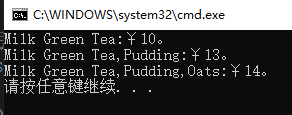装饰者模式动态地将责任附加到对象上。若要拓展功能,装饰者提供了比继承更有弹性的替代方案。
1. 角色
- 抽象构件(Component)角色:要包装的原始对象,是一个抽象类或接口。
- 具体构件(ConcreteComponent)角色:最终要装饰的实际对象,是Component的实现类。
- 装饰(Decorator)角色:是一个抽象类,继承自Component,同时持有一个对Component实例对象的引用。
- 具体装饰(ConcreteComponent)角色:具体的装饰者对象,是Decorator的实现类,负责给ConcreteComponent附加责任。
2. Demo背景
- 一个奶茶店每款奶茶可以自己选添加一些辅料如燕麦,布丁,红豆,珍珠等等。添加辅料不同可能价格也不同,又或者是我们全都要,同时添加多种辅料,这样我们设计对象时就遇到了困难,难道要排列组合去创建子类吗?这样做显然是不好的,类数量爆炸,设计死板。在这时候我们就可以引用装饰者模式,用组合的方式代替继承。
3. 代码实现
- 抽象构件类(Component):MilkyTea
public abstract class MilkyTea(奶茶)
{
public string description;
public abstract double GetFee();
//与java不一样,java父类方法不需要加关键词Virtual就可以在子类中重写
public virtual string GetDescription()
{
return description;
}
}- 具体构建类(ConcreteComponent):MilkGreenTea(奶绿)
public class MilkGreenTea : MilkyTea
{
public MilkGreenTea()
{
description = "Milk Green Tea";
}
public override double GetFee()
{
return 10;
}
}- 装饰类(Decorator):CondimentDecorator(辅料)
public abstract class CondimentDecorator : MilkyTea
{
public MilkyTea milkyTea;
}- 具体装饰(ConcreteComponent):Oats(燕麦),Pudding(布丁)
public class Oats : CondimentDecorator
{
public Oats(MilkyTea milkyTea)
{
this.milkyTea = milkyTea;
}
public override double GetFee()
{
return 1 + milkyTea.GetFee();
}
public override string GetDescription()
{
return milkyTea.GetDescription() + ",Oats";
}
}
public class Pudding : CondimentDecorator
{
public Pudding(MilkyTea milkyTea)
{
this.milkyTea = milkyTea;
}
public override double GetFee()
{
return 3 + milkyTea.GetFee();
}
public override string GetDescription()
{
return milkyTea.GetDescription() + ",Pudding";
}
}- 测试代码与运行结果
static void Main(string[] args)
{
MilkyTea tea = new MilkGreenTea();
Console.WriteLine($"{tea.GetDescription()}:¥{tea.GetFee()}。");
tea = new Pudding(tea);
Console.WriteLine($"{((Pudding)tea).GetDescription()}:¥{tea.GetFee()}。");
tea = new Oats(tea);
Console.WriteLine($"{tea.GetDescription()}:¥{tea.GetFee()}。");
}
4. 优缺点
- 优点:为设计注入弹性。满足开闭原则,方便拓展。
- 缺点: 在设计中会加入大量小类。





















 3286
3286











 被折叠的 条评论
为什么被折叠?
被折叠的 条评论
为什么被折叠?








